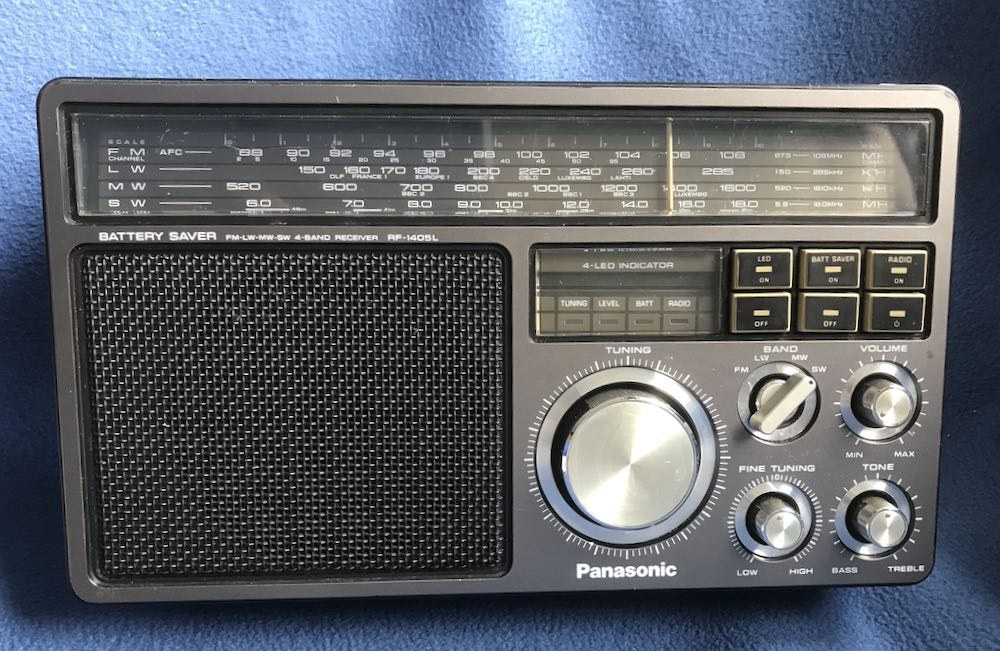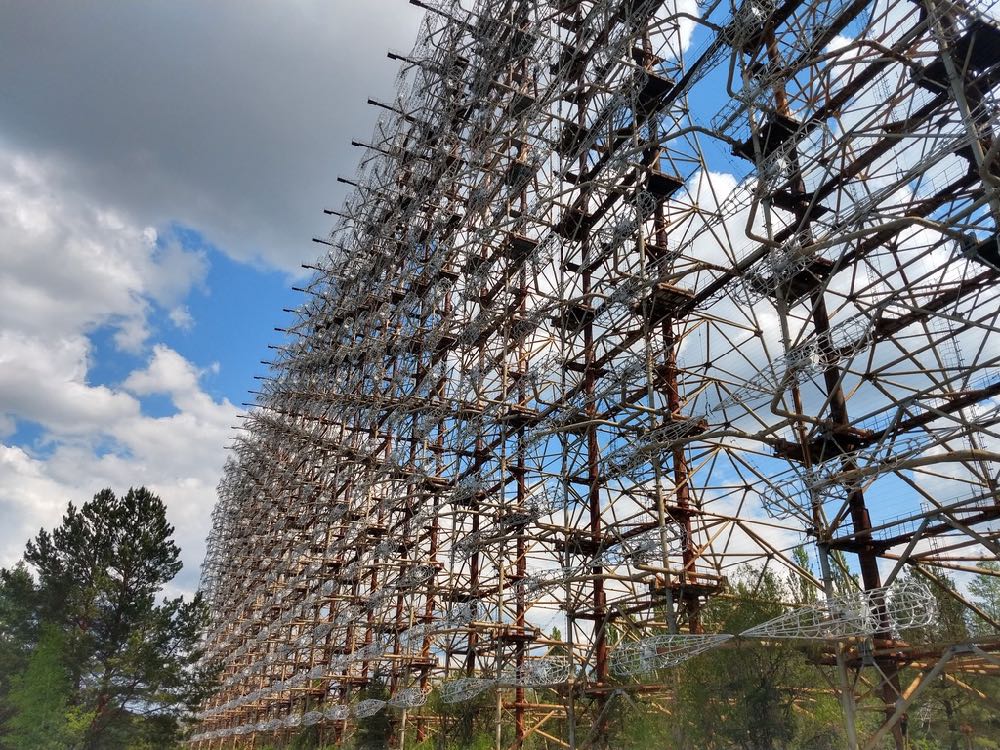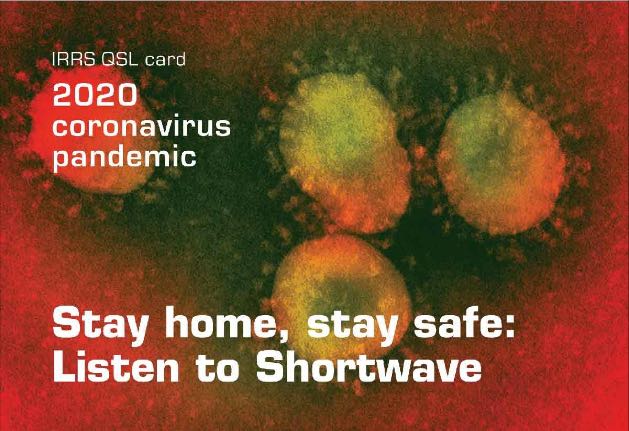Many thanks to SWLing Post contributor, Arecki, who notes that the HFCC shortwave broadcast schedules for the A20 summer period are now available.
Monthly Archives: March 2020
Panasonic RF-1405: Mark seeks advice cleaning handle on thrift store find
Many thanks to SWLing Post contributor, Mark Hirst, who writes:
Going to a local UK charity shop will usually turn up a grim selection of romance novels, old DVD box sets and children’s toys. They do a brisk trade in clothing, shoes and bags, but technology often consists of dire examples of cheap DVD players, phone cases, and small TVs.
It’s those very occasional gems that keep me going back.
Last Sunday a Panasonic radio turned up, and being a canny eBay savvy charity, they put a proper price tag on it! Aside from a scratchy volume control which was easily sorted, it seems to work fine. Spanning the whole of shortwave on a single band selection makes for tricky use of the big tuning knob, but back in the eighties I suspect this wasn’t a problem.
Finger marks and general grime have cleaned up fine, but the handle is strangely marked, and after fruitless cleaning with cotton pads and a little water I’m wondering if this is some kind of oxidation below the shiny surface.
I’m wondering if other readers are familiar with this kind of problem?
What a great score at the thrift store, Mark! I have several receivers of the same era that have the same issue on their chrome/metal parts. It’s almost as if the chrome/metallic finish is pitted in some way.
Readers: Do you know how Mark could safely clean the marks off of the chrome finish on the handle of his RF-1405?
FYI, here’s a video of Mark’s RF-1405 tuned to CRI:
Mark, you certainly snagged a great radio at the thrift store!
FCC hope to hire Pirate Radio hunters
(Source: Inside Radio)
Broadcasters would likely call it money well-spent, but it’s still cash coming from the federal government’s hands. The Federal Communications Commission estimates it will cost the agency at least $11 million to enforce the newly-adopted law that requires it to step up pirate radio enforcement. “Specifically, in order to combat the problem of illegal radio operations, the statute requires a sweeping process that will require new equipment and a substantial number of additional field agents to implement fully,” FCC Chair Ajit Pai told a Senate Appropriations subcommittee during a hearing on Tuesday. Pai said he hoped congressional budget writers would determine a “reasonable funding level” for the FCC that reflects that added cost, suggesting the agency’s budget for the upcoming fiscal year should be raised to $354 million.
Signed into law by President Trump last month, the Preventing Illegal Radio Abuse Through Enforcement Act, or “PIRATE” Act (S.1228) was unanimously approved by both the Senate and House. The new law raises fines on unlicensed station operators to $100,000 per day per violation, up to a maximum of $2 million. In addition to tougher fines on violators, the FCC would also be required to conduct sweeps in the five cities where pirate radio is the biggest problem—New York, Los Angeles, Chicago, San Francisco and Dallas—at least once a year. And then, within six months, field agents would be mandated to return to those markets to conduct “monitoring sweeps” to determine whether the unlicensed operators simply powered back up or changed frequencies. The agency would also be required to issue a report to Congress on an annual basis about its pirate-fighting efforts.
Pai told the Financial Services and General Government Subcommittee that the FCC is already gearing up for implementing the new law. “We are submitting a formal amendment to the Office of Management and Budget concerning costs associated with the full implementation of the PIRATE Act,” said Pai.[…]
Radio Waves: First Microprocessors, Ocean FM, SWL Interviews, and NPR’s take on All-Digital AM
 Radio Waves: Stories Making Waves in the World of Radio
Radio Waves: Stories Making Waves in the World of Radio
Because I keep my ear to the waves, as well as receive many tips from others who do the same, I find myself privy to radio-related stories that might interest SWLing Post readers. To that end: Welcome to the SWLing Post’sRadio Waves, a collection of links to interesting stories making waves in the world of radio. Enjoy!
Many thanks to SWLing Post contributors Marty, Martin Butera, and the Radio Survivor for the following tips:
The Surprising Story of the First Microprocessors (IEEE Spectrum)
Transistors, the electronic amplifiers and switches found at the heart of everything from pocket radios to warehouse-size supercomputers, were invented in 1947. Early devices were of a type called bipolar transistors, which are still in use. By the 1960s, engineers had figured out how to combine multiple bipolar transistors into single integrated circuits. But because of the complex structure of these transistors, an integrated circuit could contain only a small number of them. So although a minicomputer built from bipolar integrated circuits was much smaller than earlier computers, it still required multiple boards with hundreds of chips.[…]
Ocean FM Was Fire: How Local Radio Done Right Can Heat A Cabin | Radio Schmaltz (Part-Time Audiofile)
[…]The cabin on a rocky peninsula in Northwest Ireland might not have had all the letters for its Scrabble set or a microwave, but it did have another marvel of 20th century technology. It was a little CB/AM/FM radio crouching behind a box of matches on top of a kitchen cabinet.
I decided to put the switch on FM and started swirling the dial. As soon as I heard a lilting woman’s voice underneath a sheet of static, I began carrying it around the tiny room while adjusting the rabbit ears.
Now the signal was as clear as the peat-rich water was brown, a farmer was being interviewed about the economic downturn. It was a quick piece — just some brogue-ish assurances that one doesn’t choose agriculture for an easy life. Then came a trio playing an Irish ballad, and then came North West Hospice Bingo: a bingo game that allows listeners from across the broadcast range of Ocean FM’s two regional frequencies to play bingo, including the residents of the hospice.
I’d bundle up for walks outside where the wind was loud, blustery, and sacred. The ocean crashed against the rocks in a way I never conceived as being real outside of movies. But when I was inside, the radio might as well have been a Soviet relic with only a volume control and no tuner because I simply couldn’t touch that dial. I learned the schedule quickly, timing walks and firewood runs so that I’d be back in time for Country Jamboree, a boy-girl-boy-girl style line-up of Irish and American country tunes.
As I’d stand by the wood-stove, taking off my cold wet socks to put on the toasted, at time singed socks that I’d been roasting, I felt the fulfillment of the promise of radio. I could hear Fessenden making history with the first radio broadcast of music, Oh Holy Night transmitted on a rocky coast on Christmas Eve of 1906 and heard by ships at sea.[…]
Coffee and Radio Listen
Coffee and Radio Listen is an investigation of Brazilian radio listener, by Martin Butera.
How they began listening to radio, the local or international stations that influenced them, the interests they have when tuning to a station, the languages they like to listen to, if they send listeners reports and collect QSLs, their antennas and receivers, and all aspects related to the radio listen both in shortwave and in other bands and modes.
Each month they will have in this blog, an exclusive interview with a Brazilian radio listen. At the end of this project, a free downloadable e-book will be available, which contains all the interviews and statistical references.
Every month there will be a new interview, this month of March launch month we start with 2 interviews
Martin is Argentinian, born in the city of Buenos Aires capital. He currently lives in Brasília DF, capital of Brazil. He is also a journalist, documentary maker and founding member of Radio Atomika 106.1 MHz (Buenos Aires, Argentina).
To know more about CREW 15.61 Radio Listeners’, please visit the following link.
Collaborate on this project by Martín, our friend Rob Wagner (VK3BVW), Mount Evelyn DX Report (adapting the recordings).
Click here her to check out the Coffee And Radio Listen website.
NPR Supports All-Digital on AM, With Caveats (Radio World)
National Public Radio “generally supports” allowing stations to transition, if they wish, to all-digital AM transmission using HD Radio in the United States. But it believes the commission needs to go further on how it would handle interference complaints from neighboring analog stations in the band.
About 80 AM public radio stations are affiliated with NPR or receive operational funding from the Corporation for Public Broadcasting, including WNYC(AM) in New York City.
NPR says it has significant interest in any measures to help AM broadcasters better serve the public by improving the listening experience.
“Facilitating the expansion of HD Radio and its additional functionality for program and public safety information and services would serve the public interest, provided the transition to all-digital HD Radio operation does not cause harmful interference,” NPR wrote in comments filed with the FCC this week.
“As it has in the past, NPR supports the expansion of HD Radio, but not at the expense of current analog AM service.”[…]
Do you enjoy the SWLing Post?
Please consider supporting us via Patreon or our Coffee Fund!
Your support makes articles like this one possible. Thank you!
BBC Reel: “The secret Soviet radar hidden in Chernobyl’s shadow”
(Source: BBC Reel)
In a remote forest, a few kilometres from the Chernobyl power plant, the huge Duga-2 radar tower stands as relic of Soviet mismanagement.
Black Cat HF Weather Fax updates
Black Cat Systems has just announced a version update to their popular Weather Fax software. Black Cat software engineer, Chris Smolinski, notes:
I have updated Black Cat HF Weather Fax to version 1.1, which adds a bunch of new features from the series of betas, such as a built in schedule of fax transmissions, as well as interfacing to my free Uno UDP app which lets it control the frequency of SDRuno. Just click on a transmission in the schedule, and SDRuno will be retuned. Effortless Fax DXing 🙂
For Windows and macOS. More details and downloads here:
https://www.blackcatsystems.com/software/hf_weather_fax.html
Shortwave broadcasters step up Covid-19 awareness and news
Several private shortwave broadcasters have been adding Coronavirus information and news to their scheduled programs.
One of the first broadcasters to make an announcement was the IRRS–they have even made a special QSL card available. Here’s their release via the WRTH Facebook page:
Hello There from IRRS & EGR,
1.) While most of Northern Italy has come (nearly) to a halt due to the recent coronavirus outbreak, we have just extended our global coverage with daily broadcasts to reach out to Europe, the Middle East, Asia/Pacific and Africa with daily news and commentaries on COVID-19 in English.
Here are our new (daily) frequencies as of Feb. 21, 2020 (@ 150 kW):
9640 kHz (1400-1500 UTC) to Asia and Middle East
7290 kHz (1800-2000 UTC) to Europe
9660 kHz (2000-2100 UTC) to Africa
594 kHz (2100-2200 UTC/2200-2300 CET) AM/Medium Wave to N Italy and Southern/Central EuropePlease check our blog for more details at:
https://nexus.org/coronavirus-qsl/You may find our updated B19 frequency schedule at:
https://nexus.org/schedules2.) On the occasion we have released our new QSL card available electronically for all reception reports.
3.) Additionally, new broadcasts have been started as of today March 4, 2020 in Oromo language to Ethiopia on 11990 from 1500-1600 UTC (@ 250 kW).
You may send your reception report for any of our broadcasts to [email protected]. We will gladly acknowledge all verified reception reports with our new electronic QSL.
When requesting our QSL card, please consult our Privacy Policy at https://nexus.org/privacy and learn how we process your personal data according to the GDPR.
Stay home, stay safe: listen to Shortwave!
73s,
Ron
John with VORW has also shared the following announcement:
As the Coronavirus Pandemic continues to develop, I am now including 20 minutes of news and discussion concerning the virus in every broadcast. This new segment features a recap of the day’s major news developments regarding COVID-19, updated infection totals, analysis of the situation and common-sense tips and things to consider during this outbreak. Our main frequency to North America is 5850 kHz with new shows at 0200 UTC every Friday, Saturday, Sunday and Monday (10 PM Eastern every Thursday, Friday, Saturday and Sunday).
Additional times & frequencies are listed below.
1300 UTC Thursday – 15770 kHz to Europe
2000 UTC Thursday – 7780 kHz to Eastern North America
2100 UTC Thursday – 7780 kHz to Europe
2200 UTC Thursday – 9955 kHz to South America
0000 UTC Friday – 9395 kHz, 5950 kHz to North America
0100 UTC Friday – 7780 kHz to Europe
0200 UTC Friday – 5850 kHz to North America
2100 UTC Friday – 9955 kHz to South America
0200 UTC Saturday – 5850 kHz to North America
2200 UTC Saturday – 9395 kHz, 6115 kHz to North America
0200 UTC Sunday – 5850 kHz to North America
2200 UTC Sunday – 7780 kHz to Europe
0200 UTC Monday – 5850 kHz to North AmericaListener comments and QSL Reports are welcome at [email protected]
Feel free to comment on this post with any additional special shortwave broadcasts. Thanks to several readers who have forwarded tips!









